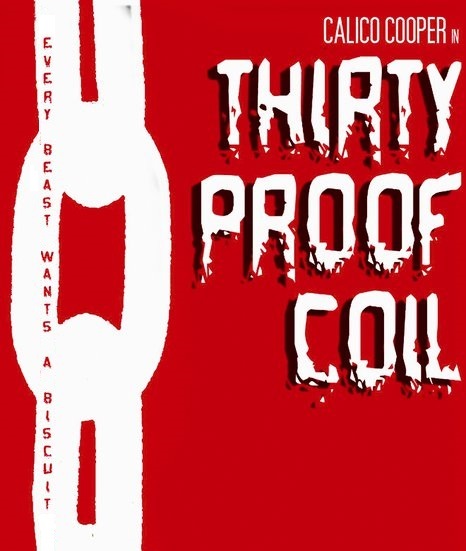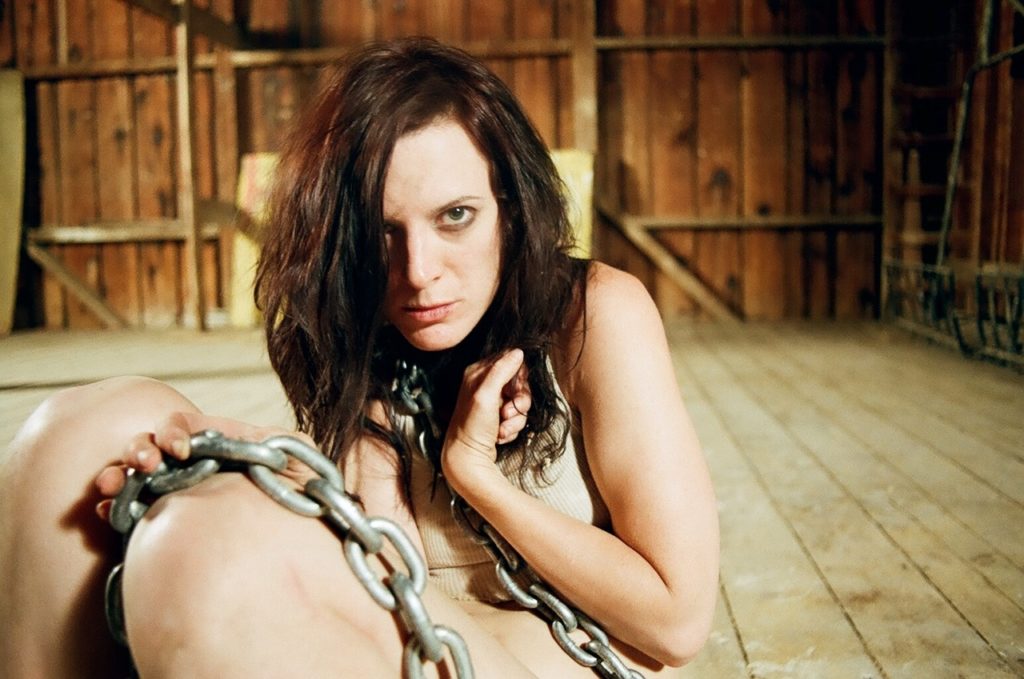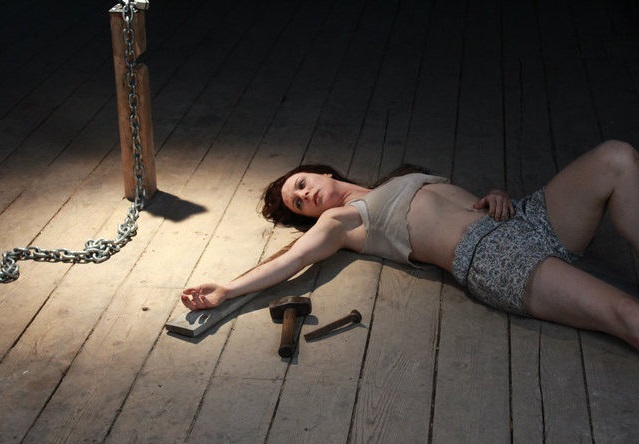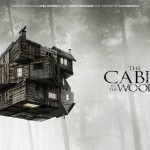
Thirty Proof Coil (from writer/director Will Schmeckpeper) begins with a foreboding fish in a bowl, cutting to close-ups of a woman’s bare feet, as she scurries from room to room in a house. Blue jean shorts and a midriff-baring top reveal more. Soon enough, jet-black unkempt hair and a face prove that she is, indeed, her father’s daughter—Calico Cooper (the daughter of rock star, Alice Cooper). As she hoists a backpack on her shoulders—a pack over twice the length of her own body–she’s in for a long day of hiking in the great outdoors (or so, she thinks). What follows is an impulsive off-road trek, transforming a would-be day of fun into days and nights of torment and horror. For the next 80 minutes, viewers will find it hard to stop watching an experience that defies the odds of becoming monotonous…again and again.
“Clearly, I’m a sado-rapist, douchebag, fuck-wad dick.” ~ The Man
A 30 proof coil is a chain with tensile strength good for pulling or restraining—certainly more strength than what’s necessary to restrain a human. The movie’s title—Thirty Proof Coil—along with the chained woman on its poster, make us quickly think of torture porn. Yes! Immediately, we expect a z-grade, pseudo-snuff film, with a woman (of course) subjected to all manner of sexual depravity. Gratuitous rape, torture, and murder are a given in such films and, indeed, this would seem to be one of them. However, is that what we get? No. Far from it. Instead, we have a movie that is not sexual, any more so than we have characters that are male and female. Thirty Proof Coil (hereafter referred to as TPC) is, for those who care to think, much more. Yes! On top of the torture-porn façade, some reviews describe the movie as nothing more than 80 minutes about a woman chained to a post in a barn. However, lazy thinkers should not embarrass themselves as much. TPC is a film that is more mental than physical (mental with complexity, as well).

30 Proof Coil – good for pulling and restraining.
The physicality of the film is obvious. A woman is shackled and chained to a wooden post in a barn. The post is buried in twelve feet of concrete, and the chain is secured to the post by a metal bolt driven down the center (just in case a captive tries to use the chain to saw through the post.) Wow! The physical work involved in trying to free yourself from this is painfully obvious…and the woman endures every bloody bit of it! Oddly, as the main character notices, the restraint is designed for more than holding your average woman captive. But, what else could the self-described “sado-rapist, douchebag, fuck-wad dick” want?
“I’m real interested to find out what you’ll do when the hunger…the real hunger…sets in.” ~ The Man
The mental element of the film is massive. Spending days chained to a post in a barn is something most of us will luckily never experience. However, for “The Woman,” delusions and madness are the result. Imagining (and talking to) dogs, clowns, Easter bunnies, as well as a mom and kidnapper who aren’t really there, are ways she passes the days. What would Jesus do? What would Bruce Campbell do?” and finally, always, “What would Alice Cooper do? A later reference to what MacGyver would do is one of the highlights of the film’s macabre humor. It is such journeys into the ever-maddening psyche of “The Woman” that engages viewers, creating the real horror of the story. Claustrophobic fear and despair develop, when all hope of escape seems lost, with the suffocating reality of death surrounding, ever closer.

The woman (Calico Cooper), kidnapped and restrained, in 30 proof coil.
It is interesting but understandable that none of the characters in the movie have names. It makes sense, because none of the characters have a need or desire to reveal their names. The woman is only a captive, and the man is only a kidnapper. Character names are also not listed in the credits. Cooper’s character is listed only as “The Woman,” the kidnapper’s name is only “The Man,” the mother’s name is “The Mother,” continuing on, generically with all. Even a monster—one that may or may not really exist—is credited as simply “The Monster.” However, with the tag line, “Every beast needs a biscuit,” I lean toward believing in this monster, with or without a name, with our without the woman’s imagination.
“I guess I just like to terrorize the womenfolk. It’s a power thing, I’m sure.” ~ The Man
As for Calico Cooper, I have not seen her in other films, although IMDb currently credits her with 22 other productions. However, in TPC, she is “The Woman,” representing humanity in a believable, compelling way. It is an easier task to portray a woman simply chained to a post; but, it is a task of greater difficulty portraying a woman descending into madness, in measured amounts that don’t go over the top, becoming a caricature of reality. The former is exactly what Cooper does. With this, she is the backbone of the movie, committed to the performance, with resounding success. Without such a skilled actress, the same movie could have been an unintended comedy and failure. What’s better is the humor Cooper adds. Her spot on imitation of MacGyver, talking about fashioning a uterus into a cell phone and making a call, is hilarious—as much as the subject matter may make it seem impossible. This is delivered so naturally that viewers are drawn to her character as they would be to a friend telling a joke. Other unexpected humor is pulled off as well, parodied with seriousness (particularly in dreams and delusions), accentuating the humor and the horror at just the right moments. Cooper’s imitations of her father, Alice Cooper, are welcome treats for fans, while his on-stage love of blood fits in just right with story. As a bonus, her genetic resemblance to her father is uncanny! Yes! For someone few know for her acting skills, Calico Cooper is just the right woman for the “The Woman.” She makes her a believably scared, desperate, smart, and tough-as-nails heroine, ultimately delusional and demented through her experiences.

Will the woman be the “bisuit” every beast needs…or, will she escape to hike another day?
“The Man” (Tate S. McCullough), as mentioned earlier, describes himself (at least in the woman’s delusions) as a “sado-rapist, douchebag, fuck-wad dick.” But, what is he really? He kidnaps the woman, feeds her (and makes damn sure she eats), but otherwise does nothing that such characters usually do to women in such movies. The man does not rape her or torture her. He only physically abuses her by hitting her with a club, in order to capture her initially and later to make her eat. Why is he only so interested in making her eat? The only word he ever utters is “eat,” after dousing her with a bucket of water to wake her up. Later, after something surprising occurs, the man is more talkative (and humorous) than ever, truly earning his part in a supporting role. Yes! Although he’s a one-word character initially, McCullough comes to life, literally, and nearly steals the show in his talking parts. A character who, with his darkened aviator sunglasses is nearly unseen, is most powerful as only a voice. However, with whatever is revealed, the question remains and grows; it is one about “The Man” that intrigues us and compels us to continue watching. Who is this anonymous man, in overalls and aviator glasses, with a desire to only make the woman eat?
“You took me for a smoker. Hence, I’m smoking. I guess now I’m a smoker. Filthy habit. These things’ll kill ya.” ~ The Man
Another looming question is one I ask only because of the camera’s intentional perspective, at times. While it seems a no brainer that certain characters are no more than figments of a maddening imagination, it may not be so obvious. In a particular scene where the Easter Bunny hops by, viewers see this happening behind the back of the woman, who seems unaware of it happening, and certainly unable to see it herself. Are we also seeing what she thinks is happening behind herself, from her own mental perspective? Are we seeing the thoughts inside of her head, as much as we are seeing the images she imagines in front of her eyes? Or, are we, perhaps, seeing what is really happening, as witnesses to a bizarre objective reality? Or, are we seeing something from a perspective that the director and cinematographer did not consider carefully enough…perhaps as a mistake? Whatever the answer may be, the question reverberates with intrigue.

Does this 30 proof coil await the woman, or does she leave it behind?
Without a doubt, some will persist in thinking that TPC is nothing more than a movie about a woman chained to a post in a barn. For some, that is, indeed, all it will ever be. However, for those who use that convoluted organ called a brain, firing your synapses through the pathways of neurons and thought, ever deeper, there is a reward to be found. The woman’s seemingly errant delusions and dreams may just make sense. Since we are also human, her horror could be our own, born from something we know in our collective consciousness, repressed, connected to fear and desperation to survive. Since we are human, her madness may also be our own. Yes! If no one ever chains you to a post in a barn, with a 30 proof coil to hold you, consider yourself lucky. If someone ever does, God help you. Perhaps then, Thirty Proof Coil will be more than a movie about a woman chained to a post in a barn. Perhaps then you will understand.
“What would MacGyver do? Would he be like…I’ll fashion a cell phone out of your uterus and call someone to get me the fuck out of this barn.” ~ The Woman
In the meantime, since I’ve told you far from everything, questions do remain. If not for torture and rape, why did the man kidnap the woman? Is the kidnapper really a “sado-rapist, douchebag, fuck-wad dick”? What would Jesus, Bruce Campbell, McGyver, and, yes, Alice Cooper really do? What do the clown, the Easter Bunny, and the random people in the park have to do with all of this? Why do the random people in the park talk like they just inhaled helium? Is there really a monster that attacks during the day (not at night) stalking outside the barn? Is “The Woman,” perhaps an intended meal (or “biscuit”) for “The Monster” that may or may not really exist? With so many questions, still more remain!

The woman (Calico Cooper), ready to have her hand nailed to a cross, behind the scenes.
One question I have finds definite flaw with the movie, although not in a major way. Why does the body (that I will not name to avoid a spoiler) not develop rigor mortis or show signs of decomposition, after days of being dead? The body obviously begins to stink, since the woman holds her nose while near it. How difficult would it be to add some special effects to bloat the body or ask the actor to stiffen his limbs? Not too difficult, I say, for the sake of realism. Such issues that distract from a movie, causing viewers to disbelieve or question objective reality, are never good.
“We sent you to college all those years so you could solve a little problem like this. So I suggest you get to it!” ~ The Mother
Overall, TPC is a descent into madness that compels us to watch it, all the more so because of the questions it raises. Some may feel cheated that answers are not handed to them in the end, neatly, leaving nothing to imagination. Those upset by dreams and delusions creating realities of choice may feel further cheated. Most viewers, however, will watch it to the end, even though it is 80 minutes with a woman chained to a post. Deep thinkers will enjoy the open-ended challenge to analyze, finding purpose for what is otherwise monotony, and order for what is otherwise chaos. Deeper thinkers will reach a conclusion on their own, happy, if not confident, with their choice. Although you may not feel the need to see Thirty Proof Coil again, the first time is worth every minute! Bring on those clowns, Easter Bunnies, mysterious kidnappers, monsters, and talking dead people! Even a thirty proof coil can’t hold them back!
Thirty Proof Coil also stars Lana Roberts (as The Easter Bunny), Jim Van Dam (as the clown), and Annie Cosho (as The Mother), with cinematography by Chaz Gentry, editing by Will Schmeckpeper, and special effects by Amanda Lamm. The movie is available on DVD, from Fenix Pictures.

Rocket Rating – 7
Chris Rennirt (the author of this review) is a movie critic and writer in Louisville, Kentucky, as well as editor in chief at Space Jockey Reviews. He has been a judge at many film festivals, including Macabre Faire Film Festival and Crimson Screen Film Fest, and he attends horror and sci-fi conventions often. Chris’ movie reviews, articles, and interviews are published regularly on Space Jockey Reviews and in Effective Magazine. His mission statement (describing his goals as a movie critic and philosophy for review writing) can be found on the “Mission” page, here at SJR. For more information about Chris Rennirt (including contact details, publicity photos, and more), click here.










